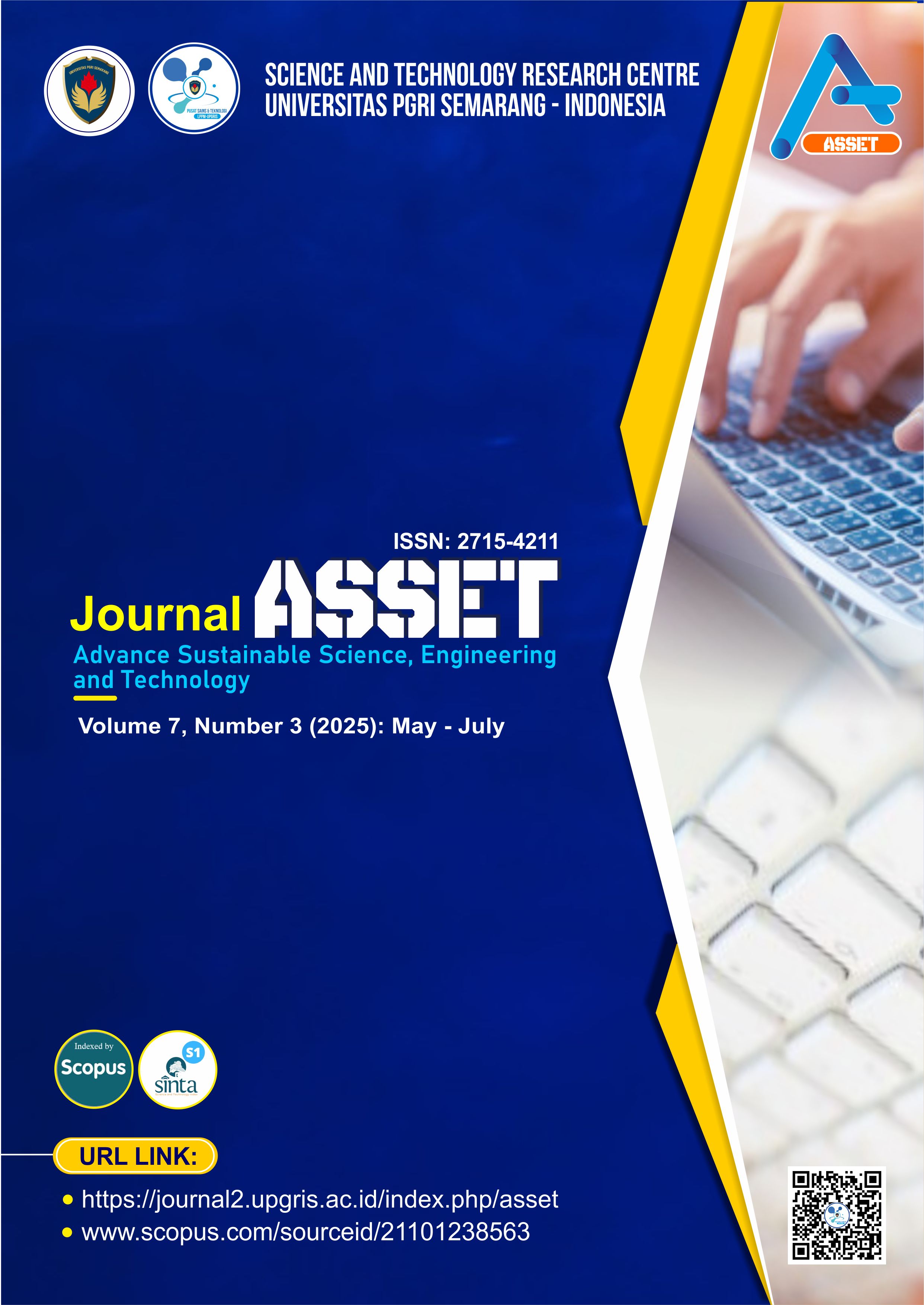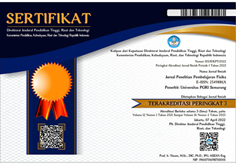Effect of Biomass Feedstock Granulometry on Thermophysical Characteristics of Charcoal Briquettes via Screw Extrusion
DOI:
https://doi.org/10.26877/asset.v7i4.2047Keywords:
biomass densification techniques, coconut shell charcoal briquette, screw extrusion biomass processing, renewable solid fuel performanceAbstract
The present study investigates the impact of particle size variation (10, 18, 20, and 35 mesh) on the physical and thermal properties of charcoal briquettes from coconut shells manufactured with a screw-based extruder machine. The briquette manufacturing process involves crushing, mixing, molding, and drying. Assessments were conducted to ascertain friability, compressive strength, density, calorific value, volatile matter, ash content, fixed carbon, and water content. Comparable assessments were also performed on commercially available export-grade briquettes designated as b_5. The results of this investigation demonstrate that all briquette samples generated conform to the SNI 01-6235-2000 standard for water, ash, and calorific value, and adhere to international standards for fixed carbon, density, and compressive strength. The b_4 specimen (35 mesh) demonstrated the best performance, exhibiting a friability of 0% in the unburned condition and 7.04% in the burned condition. Compared to b_5, the b_4 specimen exhibited notable enhancement, demonstrating a 100% increase in friability in the unburned condition and a 53.22% improvement in the burned condition. This study emphasizes the significance of smaller particle sizes in improving briquettes' mechanical strength and combustion efficiency. It presents the importance of renewable energy technology and sustainable waste management.
References
[1] Vieira F, Santana HEP, Jesus M, Santos J, Pires P, Vaz-Velho M, et al. Coconut Waste: Discovering Sustainable Approaches to Advance a Circular Economy. Sustainability (Switzerland) 2024;16:1–15. https://doi.org/10.3390/su16073066.
[2] Anis S, Fitriyana DF, Bahatmaka A, Anwar MC, Ramadhan AZ, Anam FC, et al. Effect of Adhesive Type on the Quality of Coconut Shell Charcoal Briquettes Prepared by the Screw Extruder Machine. Journal of Renewable Materials 2024;12:1–16. https://doi.org/10.32604/jrm.2023.047128.
[3] Heriyanti AP, Bakri SNS, Jabbar A, Kholil PA, Amelia RN, Savitri EN, et al. Exploring Biochar Briquettes from Biomass Waste for Sustainable Energy. Advance Sustainable Science, Engineering and Technology 2025;7:0250303-01–17. https://doi.org/10.26877/7mhm6t05.
[4] Kaur A, Roy M, Kundu K. DENSIFICATION OF BIOMASS BY BRIQUETTING: A REVIEW. International Journal of Recent Scientific Research 2019;10:30693–5. https://doi.org/10.24327/IJRSR.
[5] Mencarelli A, Cavalli R, Greco R. Variability on the energy properties of charcoal and charcoal briquettes for barbecue. Heliyon 2022;8:1–9. https://doi.org/https://doi.org/10.1016/j.heliyon.2022.e10052.
[6] Kamdem BM, Lemaire R, Nikiema J. Insight into the production factors influencing the physicochemical properties of densified briquettes comprising wood shavings and rice husk. Industrial Crops and Products 2025;223:1–16. https://doi.org/https://doi.org/10.1016/j.indcrop.2024.120134.
[7] Abdel Aal AMK, Ibrahim OHM, Al-Farga A, El Saeidy EA. Impact of Biomass Moisture Content on the Physical Properties of Briquettes Produced from Recycled Ficus nitida Pruning Residuals. Sustainability (Switzerland) 2023;15:1–17. https://doi.org/10.3390/su151511762.
[8] Pang L, Yang Y, Wu L, Wang F, Meng H. Effect of Particle Sizes on the Physical and Mechanical Properties of Briquettes. Energies 2019;12:1–16. https://doi.org/10.3390/en12193618.
[9] Zepeda-Cepeda CO, Goche-Télles JR, Palacios-Mendoza C, Moreno-Anguiano O, Núñez-Retana VD, Heya MN, et al. Effect of Sawdust Particle Size on Physical, Mechanical, and Energetic Properties of Pinus durangensis Briquettes. Applied Sciences 2021;11:1–14. https://doi.org/10.3390/app11093805.
[10] Marreiro HMP, Peruchi RS, Lopes RMBP, Andersen SLF, Eliziário SA, Rotella Junior P. Empirical Studies on Biomass Briquette Production: A Literature Review. Energies 2021;14:1–40. https://doi.org/10.3390/en14248320.
[11] Demirel C, Gürdil GAK, Kabutey A, Herak D. Effects of forces, particle sizes, and moisture contents on mechanical behaviour of densified briquettes from ground sunflower stalks and hazelnut husks. Energies 2020;13:1–19. https://doi.org/10.3390/en13102542.
[12] Nasbey H, Yahya LA, Budi AS. Optimization of the Mechanical Properties of Coconut Shell Briquettes with a Tapioca Flour Adhesive. Journal of Physics: Conference Series 2022;2377:1–9. https://doi.org/10.1088/1742-6596/2377/1/012012.
[13] Yirijor J, Bere AAT. Production and characterization of coconut shell charcoal-based bio-briquettes as an alternative energy source for rural communities. Heliyon 2024;10:1–13. https://doi.org/https://doi.org/10.1016/j.heliyon.2024.e35717.
[14] Aliah H, Winarti I, Iman RN, Setiawan A, Safarina R, Sawitri A. Influence of Sieve Size on Calorific Value and Proximate Properties of Bio-Briquette Composites. Journal of Ecological Engineering 2023;24:25–34. https://doi.org/10.12911/22998993/163309.
[15] Heya MN, Hernández ALR, Pournavab RF, Ibarra LFP, Díaz-Jiménez L, Heya MS, et al. Physicochemical Characteristics of Biofuel Briquettes Made from Pecan (Carya illinoensis) Pericarp Wastes of Different Particle Sizes. Molecules 2022;27:1–15. https://doi.org/10.3390/molecules27031035.
[16] Suryaningsih S, Nurhilal O, Yuliah Y, Mulyana C. Combustion quality analysis of briquettes from variety of agricultural waste as source of alternative fuels. IOP Conference Series: Earth and Environmental Science 2017;65:1–6. https://doi.org/10.1088/1755-1315/65/1/012012.
[17] Abdel Aal AMK, Ibrahim OHM, Al-Farga A, El Saeidy EA. Impact of Biomass Moisture Content on the Physical Properties of Briquettes Produced from Recycled Ficus nitida Pruning Residuals. Sustainability 2023;15:1–17. https://doi.org/10.3390/su151511762.
[18] Antwi-Boasiako C, Acheampong BB. Strength properties and calorific values of sawdust-briquettes as wood-residue energy generation source from tropical hardwoods of different densities. Biomass and Bioenergy 2016;85:144–52. https://doi.org/https://doi.org/10.1016/j.biombioe.2015.12.006.
[19] Mitchual SJ, Frimpong-Mensah K, Darkwa NA. Effect of species, particle size and compacting pressure on relaxed density and compressive strength of fuel briquettes. International Journal of Energy and Environmental Engineering 2013;4:1–6. https://doi.org/10.1186/2251-6832-4-30.
[20] Saeed AAH, Yub Harun N, Bilad MR, Afzal MT, Parvez AM, Roslan FAS, et al. Moisture Content Impact on Properties of Briquette Produced from Rice Husk Waste. Sustainability 2021;13:3069. https://doi.org/10.3390/su13063069.
[21] Dyjakon A, Sobol Ł, Krotowski M, Mudryk K, Kawa K. The Impact of Particles Comminution on Mechanical Durability of Wheat Straw Briquettes. Energies 2020;13:1–14. https://doi.org/10.3390/en13236186.
[22] J. Imaniraguha, T. Mushimiyimana, C. Lucas, and A. Condo. Production and characterization of briquettes from Panicum maximum Jacq. (guinea grass) and cassava peel waste. Energy Reports 2025;14:1043–1050. https://doi.org/10.1016/j.egyr.2025.07.033.
[23] J. Waluyo et al. Characterization of Biochar Briquettes from Coconut Shell with the Effect of Binder: Molasses, Cow Manure and Horse Manure. Evergreen 2023;10:539–545. doi: 10.5109/6782158.
[24] A. Sa’idu and A. Magaji. Physicochemical and Thermal Properties of Rice Husk Char From Wacot Rice Mills Argungu, For Biofuel Production And Sustainable Waste Management. Quest Journals, J. Res. Environ. Earth Sci., 2024;10:1–6.
https://www.questjournals.org/jrees/papers/vol10-issue2/10020106.pdf
[25] L. Madhusanka, H. Nilmalgoda, I. Wijethunga, A. Ampitiyawatta, and K. Koswattage. Agri-Eco Energy: Evaluating Non-Edible Binders in Coconut Shell Biochar and Cinnamon Sawdust Briquettes for Sustainable Fuel Production. AgriEngineering 2025;7:1–20. doi: 10.3390/agriengineering7050132











